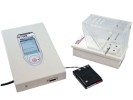Authors
C. Rivat, P. Richebé, E. Laboureyras, J.-P. Laulin, R. Havouis et al.
Lab
UMR CNRS 5227, “Mouvement-Adaptation-Cognition”, Team “Homéostasie-Allostasie-Pathologie-Réhabilitation”, Bordeaux, France.
Journal
Pain
Abstract
There is a compelling body of evidence that N-methyl-d-aspartate receptors (NMDA-R) play a critical role in the development and maintenance of pain hypersensitivity. However, long-term treatments with NMDA-R antagonists are limited by unacceptable side effects. Since polyamines modulate the functioning of NMDA-R and mainly originate from normal dietary intake and bacterial metabolism in the gut, we developed a nutritional therapy based on dietary polyamine deficiency. Here, we reported that a polyamine deficient diet (PD diet) for 7 days prevented the enhancement of tyrosine phosphorylation of the spinal NR2B subunit-containing NMDA-R associated with inflammation in rats. Based on these data, we studied the ability of PD diet to prevent long-lasting pain hypersensitivity associated with tissue injury on one hind paw by evaluating long-lasting changes in both mechanical nociceptive threshold and weight bearing. A PD diet strongly reduced long-lasting hyperalgesia induced by inflammation or incision, especially in fentanyl-treated rats. Moreover a PD diet also prevented the exaggerated hyperalgesia induced by a second inflammation performed 7 days after the first one. A PD diet also opposed paradoxical hyperalgesia induced by non-nociceptive environmental stress in rats with pain and opioid experiences. A PD diet reversed pain hypersensitivity associated with monoarthritis or neuropathy and restored the analgesic effect of morphine. Since PD diet was devoid of any noticeable side effects, this nutritional therapy could be part of an effective and safe strategy for pre-emptive analgesia and for reducing the transition from acute to chronic pain and its outcomes in various pain syndromes.
BIOSEB Instruments Used:
Static Weight Bearing Touch: Incapacitance Test (BIO-SWB-TOUCH-M),Dynamic Weight Bearing 2.0 (BIO-DWB-DUAL)

 Pain - Thermal Allodynia / Hyperalgesia
Pain - Thermal Allodynia / Hyperalgesia Pain - Spontaneous Pain - Postural Deficit
Pain - Spontaneous Pain - Postural Deficit Pain - Mechanical Allodynia / Hyperalgesia
Pain - Mechanical Allodynia / Hyperalgesia Learning/Memory - Attention - Addiction
Learning/Memory - Attention - Addiction Physiology & Respiratory Research
Physiology & Respiratory Research
 Pain
Pain Metabolism
Metabolism Motor control
Motor control Neurodegeneration
Neurodegeneration Cross-disciplinary subjects
Cross-disciplinary subjects Muscular system
Muscular system General activity
General activity Mood Disorders
Mood Disorders Other disorders
Other disorders Joints
Joints Central Nervous System (CNS)
Central Nervous System (CNS) Sensory system
Sensory system

